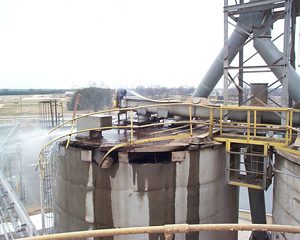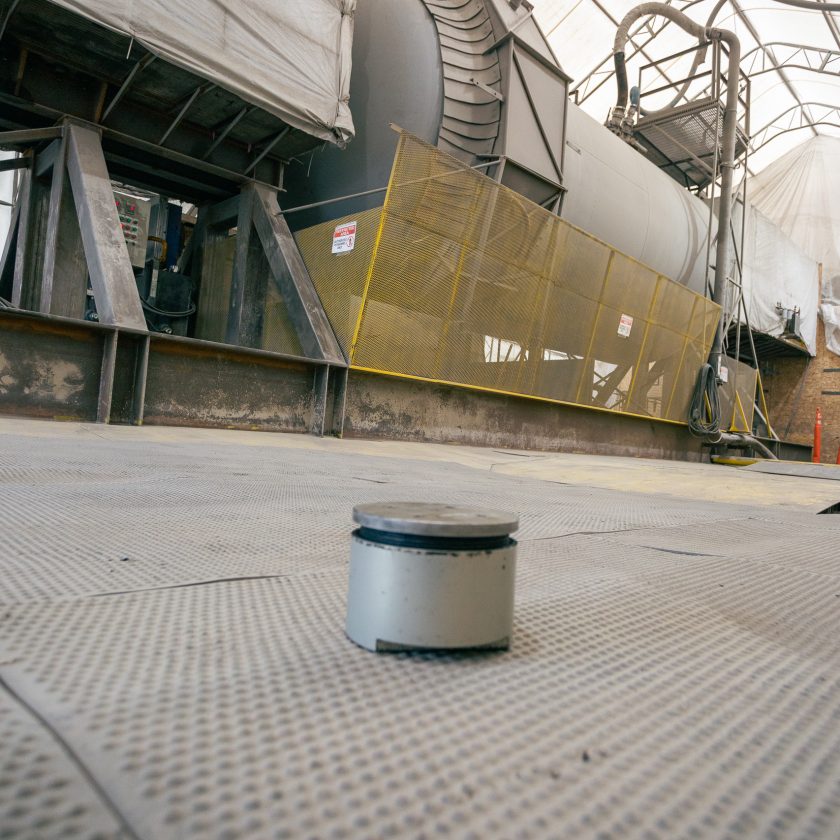How to Pick the Right Roof-Top and Silo Coating.
By Dennis Blauser and Tim Thieman
 |
| Image of a failed silo roof. |
Roofs are a fundamentally important part of any silo. They protect stored materials from the elements, offer entry points for filling and inspection and often house a variety of necessary equipment. They also typically take the greatest amount of abuse from loading, unloading, the weather, maintenance activities, and foot traffic. Due to the size of industrial storage silos, roofs are easy to overlook. Yet roof and silo wall failures not only lead to unplanned downtime and lost profits, they also compromise safety.
There are numerous news reports every year that cite critical injuries or fatalities as a result of silo roof failure. Preventive maintenance and routine inspection of silos can reduce the risk of liabilities. It is therefore recommended that all silos are inspected periodically to insure structural integrity, operability and safety.
Proper roof maintenance is needed to keep the materials within the silo safe and dry. One of the best maintenance options for many silo roofs is the application of protective coating. Coatings can be applied preventatively or used to fix minor issues. There are a variety of coating types available, each of which has different strengths and weaknesses.
Coating Options
Scientific and technological advancements influence the types of coating materials available on the market. While breakthroughs can lead to enhanced product offerings, there are a few standard coating types used for metal and concrete silos. These typically include polyurethanes, acrylics or epoxies. Many advancements are a result of mixes that contain one or more of these components.
When looking for the best silo and roof coating for your application, there are a number of specifications that should be considered. Ideally, products used for roof-top coating should be highly durable and resist foot traffic, environmental elements and industrial loading of silos to ensure product longevity and increased silo lifetime.
Like many structures, silos are subject to thermal expansion. Throughout the year, the silo surfaces expand during warmer temperatures and contract when cooled. High elasticity coatings are able to tolerate this normal expansion and contraction throughout the year without cracking or peeling.
Roof-top coatings should fully adhere to the surface material, not act as a floating membrane. The smallest hole in a non-bonded, floating membrane allows water to pass throughout the entire silo surface. This water becomes trapped between the roof membrane and the top of the slab or travels down silo walls.
 |
| Silo roof that shows clear wear from exposure to weather conditions and use. |
In times of frost and thaws, trapped water expands and contracts causing unseen, yet detrimental, damage. This unseen damage can lead to unexpected safety issues in spite of regular inspections.
Coatings should also provide excellent waterproofing and tolerate pooling water typical of a flat roof surface. Water resistance before and after drying should also be considered. Additionally, coatings should perform well despite weather extremes, and provide thermal stability, UV protection, and resistance to acids, alkali and salt.
 |
| Corroded rails and walkways on unprotected silo roof. |
 |
| Silo roof protected with rubberized coating. |
Polyurethanes – Polyurethanes used for roof-top coating include thermosetting coatings and spray polyurethane foam (SPF). Polyurethanes are not intended for use in any areas that take foot traffic. When used as a standalone roofing surface, SPF is highly susceptible to damage from even light foot traffic. While some structures may be able to safely rely on spray foam coatings, its use in aggregate storage silos is not recommended as easily damaged foam coating surfaces lead to easy water penetration. Sensitivity to humidity further limits the use of polyurethanes.
Acrylics – Known as an inexpensive material that provides good aesthetics, acrylics fall short on protection and longevity. Acrylic coatings are sensitive to ultraviolet light and cold temperatures. As such, they are prone deterioration, known as chalking, that leaves a powdery substance on the coating surface as it breaks down. Acrylics are often mixed with other coating types to improve product appearance.
Epoxies – There are several downsides to epoxy coatings. In addition to high flammability, epoxies come with a number of health risks from fumes and dust. Epoxy-based coatings also perform poorly in cold climates where freezing temperatures increase the likelihood of cracking, splitting, or peeling. Furthermore, additional coats do not automatically bond to previous coats.
Synthetic Rubbers – A highly effective coating, synthetic rubber offers numerous benefits and great aesthetics. Brands come with a variety of color choices, which all deliver excellent UV protection. Lighter colors, however, provide greater solar reflectance to help keep silo roof tops cooler and reduce the urban heat island effect.
 |
| Another image of a silo roof, freshly coated with highly-protective synthetic rubber. |
When compared to acrylic coatings, synthetic rubber coatings offer higher tensile strength, greater elongation, better adhesion to foam, and superior water, fungi and fire resistance. Unlike acrylic coatings, synthetic rubbers offer excellent protection from corrosion, salts, acids, alkali, and other environmental extremes. They also repair and seal cracks, laps, fasteners and penetrations on roof surfaces. Rubberized coatings can be rolled, painted or sprayed onto a variety surfaces to form a seamless, monolithic membrane. These include:
- Concrete silo roofs.
- Metal buildings and roofs.
- Modified bur roofs.
- Grain silos and bins.
- Silo exterior walls.
- Single ply roofs.
- Urethane foam roofs.
- Steel bolted joints.
 |
| Steel components are susceptible to corrosion from water penetration, though roof failure can also be caused by damage to the concrete supports. Silo roofs are supported by silo beams that rest on a thick, steel bearing plate inside a beam pocket. In this image, spalling concrete under the plate leaves the beam at risk for failure. |
One of the biggest benefits of rubberized coatings is its inherent ability to completely bond to these surfaces. Many coatings simply act as a floating membrane which allows for a greater rate of failure when compared to coating materials that bond directly to the silo surface.
Thermal stability offered by synthetic rubber coatings minimizes the impact of weather extremes and ensures a long product lifetime. This high-performance coating resists peeling, cracking and splitting caused by temperature extremes.
Coatings can be applied at lower temperatures than other coating types which extends the application season. Water resistant properties of rubberized coatings begin before the product is fully dry, eliminating issues caused by wash-off in unpredictable weather conditions. Thickness and number of coats necessary for rubberized coatings vary depending on specific application needs.
Finding a Contractor
Once you know the product itself meets all the specifications necessary for your precise needs, you must also consider the application process, thickness and level of company expertise. When selecting a contractor, it is ideal to choose someone with experience in preventive maintenance and repair of industrial silos.
A typical coating or roofing contractor does not understand the nuances of silo construction. It is critical to select a company that has experience with the particular design and engineering associated with both steel and concrete silos.
What to look for in a preventive maintenance company:
- Proposal and documentation clarity.
- Experience.
- References.
- Stability.
- Training and safety.
 |
| Though new silos now use suspended cones, water leakage leads to corrosion of steel silo components regardless of silo design. This suspended cone interior and steel ring girder show extensive corrosion from failed waterproofing. |
While the proper coating can greatly extend useful life, silos that are overly saturated with water or have extensive spalling, or chipping, are not always a candidate and may require resurfacing instead. When used appropriately, however, rubberized silo coating delivers optimal protection for a variety of surfaces and withstands numerous environmental extremes.
It is an economical solution that ensures product quality and silo safety. A qualified inspection, repair, cleaning, and maintenance company can recommend the solution that is most suited to your individual needs.
Dennis Blauser is the CEO of Marietta Group, which houses Marietta Silos, Marietta Inspection Services and USA Silo Service. Marietta Group has spent more than a century meeting the needs of industry professionals and is the only silo contractor in the nation that provides engineering, design, construction, inspection, repair and maintenance in addition to silo and bin cleaning. USA Silo founder Tim Thieman has spent more than 30 years developing efficient and effective methods of silo build-up assessment, evaluation, cleaning, debris removal, site safety and project-management practices.




